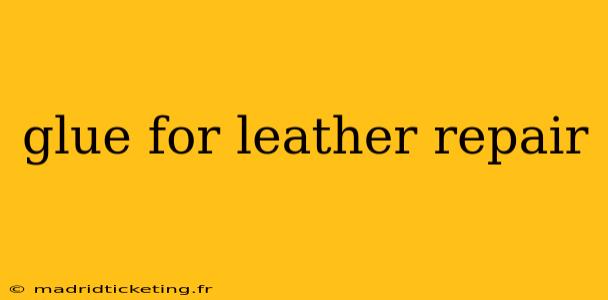Leather is a luxurious and durable material, but even the toughest hides can suffer tears, cracks, and scuffs over time. Fortunately, repairing leather damage is often achievable at home with the right tools – and the most important tool is the right glue. This comprehensive guide will delve into the world of leather adhesives, helping you choose the best glue for your specific leather repair needs.
What Kind of Glue is Best for Leather?
This is the most frequently asked question, and the answer depends heavily on the type of leather and the extent of the damage. There's no single "best" glue, but several excellent options cater to different situations. Generally, you'll want a flexible, strong adhesive that won't yellow or become brittle over time. Avoid using general-purpose glues like PVA (white glue), as these can be too stiff and prone to cracking.
What are the Different Types of Leather Glue?
Several types of glue are specifically formulated for leather repair:
-
Contact Cement: This is a popular choice for many leather repair projects, offering strong bonds and fast drying times. Contact cement works best when applied to both surfaces before pressing them together. It's ideal for heavier repairs and bonding large pieces of leather. However, it requires precision and a quick working time, and mistakes are difficult to correct.
-
Polyurethane Glue: Polyurethane-based adhesives offer exceptional strength and flexibility. They are water-resistant and ideal for outdoor leather goods or items exposed to moisture. Polyurethane glues are a great all-around option for many leather repair projects.
-
Epoxy Glue: Epoxy glues are known for their incredibly strong bond, but they can be more difficult to work with. They have a longer drying time and may require clamps or weights to keep the surfaces together during curing. Epoxy is best for more substantial repairs where exceptional strength is crucial.
-
Specialty Leather Repair Adhesives: Many companies produce adhesives specifically designed for leather repair. These often contain specialized ingredients to ensure flexibility and prevent yellowing or discoloration. Check out brands specializing in leather care products for these options.
How Do I Choose the Right Leather Glue for My Project?
Choosing the correct glue involves considering several factors:
-
Type of Leather: The thickness and type of leather will influence your glue choice. Thicker, heavier leathers may require a stronger adhesive like contact cement or epoxy. Delicate or thinner leathers might benefit from a more flexible glue like a polyurethane-based option.
-
Extent of Damage: Small tears or scuffs might only require a small amount of flexible glue. Larger repairs or significant damage often necessitate a stronger adhesive.
-
Exposure to Elements: If the repaired item will be exposed to moisture or extreme temperatures, a water-resistant glue like polyurethane is crucial.
-
Color of Leather: Some glues may yellow or discolor over time, especially with lighter-colored leathers. Opt for glues specifically formulated to resist yellowing.
Is there a Glue That Works on All Types of Leather?
While some glues perform better than others across the board, there isn't a single glue that flawlessly adheres to all leather types in all conditions. The best approach is selecting the adhesive that best matches your specific project needs, considering the factors listed above.
What if My Glue Doesn't Work?
If your chosen glue isn't providing a strong enough bond, you might have used an unsuitable adhesive for your leather type or repair. Ensure you've properly prepared the leather surfaces (cleaned and dried) and followed the manufacturer's instructions meticulously. If problems persist, it's best to try a different type of leather glue suited to the material and repair type.
What Should I Do After Applying the Glue?
Once you've applied the glue, carefully follow the manufacturer's instructions for drying time and clamping or weighting if necessary. Allow ample time for the glue to cure completely before using the repaired item to ensure a durable and long-lasting repair. Avoid excessive heat or moisture during the curing process.
By carefully considering the type of leather, the extent of the damage, and the environmental factors, you can choose the appropriate leather glue and achieve a professional-looking repair. Remember always to test your chosen adhesive on a hidden area first to ensure compatibility and color matching. Happy repairing!

